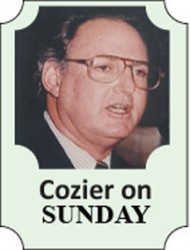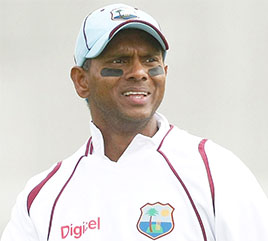By Tony Cozier
It is typical of the present state of West Indies cricket that Shivnarine Chanderpaul’s retirement from the game he mastered in his peculiar style for 21 years, 164 Tests and 268 ODIs should have been inappropriately shrouded in controversy.
It was predicated by his omission from the home series against Australia last June. Aged 40, an average of 16.64 in his previous six Tests in South Africa and in the Caribbean against England, was a sign that the end was near. The selectors’ decision showed no compassion.
The chairman of the panel, Clive Lloyd, the legendary captain of the West Indies’ prolonged period of domination in the 1980s and a fellow Guyanese, wrote to advise Chanderpaul that they had “decided to move on with younger players for the future.

It was nothing less than a letter of termination, immediately and inevitably setting off enraged reaction. Unusually, administrators found themselves on the same page as public opinion.
The Guyana Cricket Board (GCB) charged that the selectors were “seeking to destroy” Chanderpaul.
“It just cannot believe nor even fathom the thought process behind the wanton dropping of the most senior, reliable and dependable batsman of the West Indies for the past 21 years,” it fumed. “Is this the way the selectors intend to treat our esteemed cricketers after more than two decades of service to the people of West Indies cricket?”
West Indies Cricket Board (WICB) president Dave Cameron pressed the selectors to reverse their position as the board “needed to honour him.”
Even after Chanderpaul’s exclusion from the squad against the Australians was announced, Cameron arranged for him to fly from Guyana to Barbados to join the training camp, insisting that he should be picked.
Much was made of the statistic that Chanderpaul, already the West Indies’ most capped Test player, needed just 46 more runs to surpass Brian Lara’s 11,912, as the leading scorer as well; Lloyd and his panel were not for turning back.
Chanderpaul was never easily prised from the crease. Characteristically, he played on for Guyana. In the end, he missed the challenge of cricket at the highest level and accepted the unavoidable.
It will be an anguished wrench. Cricket has been his life. He was little more than a toddler when his father, Khemraj, uncle Munilal and whoever else was available in his village of Unity on the outskirts of the Guyana capital, Georgetown, bowled to him, hour after hour, in a vain attempt to dislodge him.

The first indication that the West Indies’ newest batsman had arrived was an unbeaten 203 in an under-19 ‘Test’ against England at Trent Bridge in the summer of 1993. A year later, he waddled to the wicket in outsized pads on his home ground of Bourda in Georgetown for the first of his 280 Test innings, against England. His selection, at 19, was as debatable then as was his eventual exclusion; his response was a defiant 62.
It immediately defined the character of his batting over the next two decades.
What you saw was what you got. He was the antithesis of the stereotype of the dashing West Indian strokemaker. There was none of the left-handed flair of Lara or Garry Sobers or the muscular power of Lloyd or Chris Gayle. He simply did it in his understated way, earning most of his runs with unshakable patience allied to steely wrists and a keen eye for profitable nudges and deflections through gaps in the field.
He took 510 balls and close to 11 hours to compile an unbeaten 136 against India in Antigua in 2002. In 2008, he kept Australia in the field for just under 26 hours all told without being dismissed, rousing himself from a numbing blow to the helmet to complete a hundred in Kingston.
It was not to say that his batting was entirely one-dimensional. He can lay claim to the fifth (joint with David Warner) fastest hundred in all Test cricket, off 69 balls against Australia in Georgetown in 2003. His top ODI score of 150, against South Africa in East London in 1999, required only 136 balls.
His several foibles immediately identified him at the crease, none more so than a stance that became so increasingly front-on it was generally described as ‘crab-like’. Whatever it was called, his record was proof of its success.
“When I started, I was very side-on but would work across the crease and struggle for balance,” he explained, confirming early video clips. “I gradually began to open up as I found I could balance a little better.”
It didn’t come easily. He spent hours in the nets practising the shift before he felt comfortable. It typified his determination and commitment.
But for an inevitable addition of a few ounces, he was still as slender at the end as he was at the beginning.
He never took to the diamond-studded earrings, gold necklaces and designer sunglasses that became the standard fashion wear of the youngsters around him.
He briefly experienced the infighting that can undermine any sports team when made West Indies captain in 2005 after a strike by senior players.
‘It was a very difficult period for me,’ he recalled. ‘As captain, I wasn’t getting any support. A lot of things were happening on the field. I’d come to the ground worrying how I was going to deal with these things and I couldn’t focus on my own game.’ It prompted his resignation; Lara took over for his third stint in the post.
Ever a man of few words, his views on the game came across in quiet, measured tones. They were simple and invariably made sense although not often heeded by the modern generation.
“If you play bad shots, you’re going to get out,” he once told me. “If you hit the ball in the air, you’re going to get out. If you can bat to 50, you can bat to 100.” He proved the theory 30 times in Tests, another 11 in ODIs.
He saw the advent of Twenty20 cricket as contributing to the decline in West Indies batting standards.
“Guys just give themselves room in that version and fire,” he said. “They don’t care if they get out. That’s why Test cricket will always be the ultimate. It tests you as to whether you’re a man or a boy.”
Although he can see plenty of natural talent among the batsmen who will fill his spot in West Indies teams of the future, he detected little of the discipline to go with it.
“I see guys batting well and scoring yet they still want to do something fancy,” he said. “The pitches in the West Indies may not be the best, often up and down and two-paced, either seaming around or spinning, but that’s when you should be fighting to survive, not giving away you wicket.”
These are points he is trying to drill into those now coming along. Among them is his son, Tagenarine, Brendon to family, friends and fans, who opened the batting for the West Indies in the Under-19 World Cup in 2014. Also a left-hander, he played alongside his father two seasons ago in the same Guyana team in the West Indies’ first-class tournament. His might well be the next Chanderpaul on a senior West Indies score sheet. If he follows half his father’s mantras, he will be a significant addition.
Based on his 49 not outs in Tests, selfishness is a tag sometimes attached to Chanderpaul senior. It was a charge that ignored both the effect of his position at No.6 in a team with a limp tail-end and the question of how much worse the West Indies would have been without his reliability over an active span longer than any other.
Heavy defeats in their last seven Tests already verify how much he is missed.




